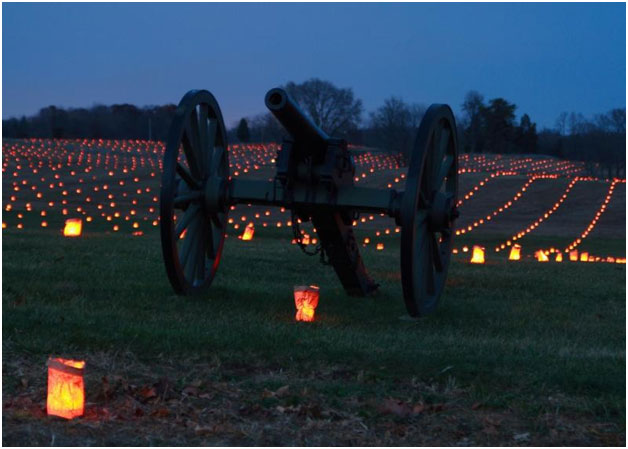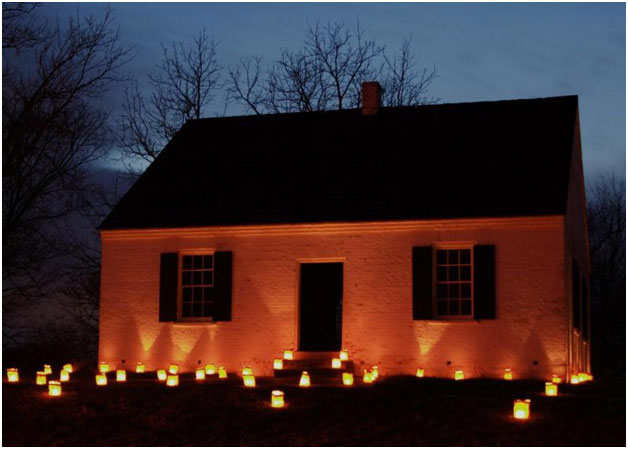The Antietam Battlefield Illumination: A Powerful Representation of the Battle’s 23,110 Casualties
The Antietam Battlefield Illumination: A Powerful Representation of the Battle’s 23,110 Casualties

Antietam National Battlefield is one of the most well-preserved Civil War battlefields in the United States. Nestled in southern Washington County, just north of the small town of Sharpsburg, Maryland, it is a place of great natural beauty. In the fall, changing leaves paint a vibrant landscape with the striking backdrop of the mountains in the not-so-far distance. There’s nothing like the quietness of the park blanketed in freshly fallen snow during the winter months. It comes to life again in the springtime when color and visitors return to the fields in abundance. During the summer deer can be seen grazing along the rolling hills at sunrise and sunset.
The battle of Antietam was a pivotal moment in the American Civil War and there were several significant factors about the September 17, 1862 battle. Perhaps the most well-known is that it was the bloodiest single-day battle in American history. Though it lasted just 12 hours, there were 23,110 casualties as a result of the battle. Three phases of horrific fighting at Miller’s Cornfield, the Sunken Road, and the Lower Bridge left 23,110 soldiers killed, wounded, and missing or captured. Approximately 3,650 soldiers were killed outright and approximately 17,300 were wounded. About one in seven soldiers died from their wounds during the Civil War.
Visiting Antietam National Battlefield is the best way to understand what happened there more than 150 years ago. You can walk the terrain, peruse interpretive wayside exhibits, participate in ranger-led programs, review maps with troop movements and even see images captured by Alexander Gardner in the days that followed the battle…gruesome images of bloated corpses laid out for burial. The one thing that’s hard to grasp when visiting the now-peaceful fields, is what 23,110 casualties strewn across the landscape would look like. The Antietam Illumination began in 1989, held every year on the first Saturday in December, to help visitors grasp that number in a hauntingly beautiful way.
Preparation begins weeks before the annual Illumination, when volunteers assemble each individual luminary – a brown paper bag filled with sand to weight it down and a special long-burning candle with an extra-long wick, manufactured by Root Candles in Ohio – and pack them in boxes that are stored until the event. The morning of the event, volunteers gather at the battlefield to get their assigned location for placing the luminaries. More than 1,400 volunteer groups comprised of scouts, church groups, school groups, friends, families and more, go about the task of placing 23,110 luminaries on the northern portion of Antietam National Battlefield.

A luminary is placed every 15 feet in designated areas, creating rows upon rows and columns upon columns. Through the years, volunteers have gotten the placement down to a science. Many use long ropes with knots every 15 feet as a guide. Ask any of the regulars who volunteer every year and you’ll find that the weather in western Maryland varies greatly in early December. There have been years where it’s been unseasonably warm with no need for a heavy coat, years where the wind chill factor has been almost unbearable with several inches of packed snow on the ground, and literally everything in between. ¬¬¬
Regardless of the weather, most anyone will tell you that the real magic happens around sunset. At 3pm volunteers return to their assigned areas and begin lighting the luminaries so that all are lighted before sunset. A special program is held for the volunteers at the Maryland Monument and by the end of that ceremony, the sun dips down out of view and the fields begin to flicker and dance with light. It’s a beautiful sight to behold, followed by the grim reality that each luminary represents ¬a father, a husband, or a brother that fell in the Battle of Antietam. It's truly breathtaking and is such a powerful visual representation of the number 23,110. If you’ve never seen this event, make plans to see it at least once in your life. It’s something that photographs can capture but can’t fully convey. Visitors are permitted to drive through the battlefield from 6pm-midnight to view the Illumination, which is free of charge, however donations are accepted. The line of cars sometimes reaches several miles in length and forms on the westbound shoulder of Route 34. For more information about the Illumination visit the Antietam National Battlefield website at www.nps.gov/anti/planyourvisit/luminary.htm.


